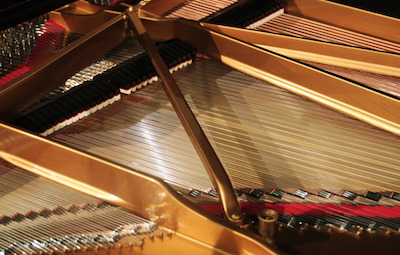What does it take to make beautiful music?
Even the best singer in the world didn’t start out that way. They sang because they enjoyed it. They sang with their favorites songs on the radio. They signed up for the school musical. And somewhere along the way a coach jumped in to help refine their music, hit the notes that made their voices sound magical. And they keep refining to this very day.
The same goes with a piano. Piano refining is about creating beautiful piano sound. Piano tone doesn’t happen at the time a piano is built. Piano tone isn’t something that’s set and never needs work again. Piano tone is something that is acquired through work and restoration, over and over again throughout the life of a piano.
And it happens whether it’s with a newly built Steinway or a decades old piano you take loving care of every day.
Why?
Every time a key is pressed and a hammer jumps into place on a string, a system is put into play. If any part of that process isn’t pure precision, the tone of the piano is “off.”
This is where tone regulation comes into play. It’s a multi-step process. It includes:
- Piano hammer voicing
- Piano string voicing
- Piano action regulation
Piano Hammer Voicing
Each time a key is pressed, the hammer strikes the string. This “whack” bends the string ever so slightly before returning to its original state. Piano hammer voicing defines how much pressure is behind the hammer when it hits the string, and how the bend in the string takes place during that contact. To regulate hammer voicing takes a variety of accomplishments, from steaming the hammer felt, to hardening the hammer, to adding or removing hammer weight, and more.
Piano String Voicing
Piano string is a stiff, taut wire. The wire is connected and wrapped around various bends and loops as it connects the pieces together. These bends and turns must occur in a certain way and be consistent to have the string vibrate in a certain way. If the turns or connections are off, the tonal effects will be anything but pleasurable.
String bends must be consistent throughout the piano. Notes use more than one string in order to produce sound; if one of the strings is off, it will impact on sound quality. String voicing is performed on all pianos, from the brand new to the decades old. Without consistent string voicing, tonal quality will always be off.
Piano Action Regulation
The piano action is the series of levers that connect the keys to the hammers. The way the hammer contacts the string defines the quality of the tone. The speed at which the process takes place also has impact. This is where action regulation comes into play. Different accelerations create different tonal qualities. With even a tiny adjustment in the speed, a tone can be dead on or completely off. Furthermore, if the action doesn’t provide precision connection between the hammer and the string, connection isn’t perfection and the result can be noisy and harsh.
For all of this to happen in unison, it takes a specially trained technician to fully adjust every part, every step of the way. With 37 steps in the process, it’s important to have an expert who knows how to retain tonal quality every time.

